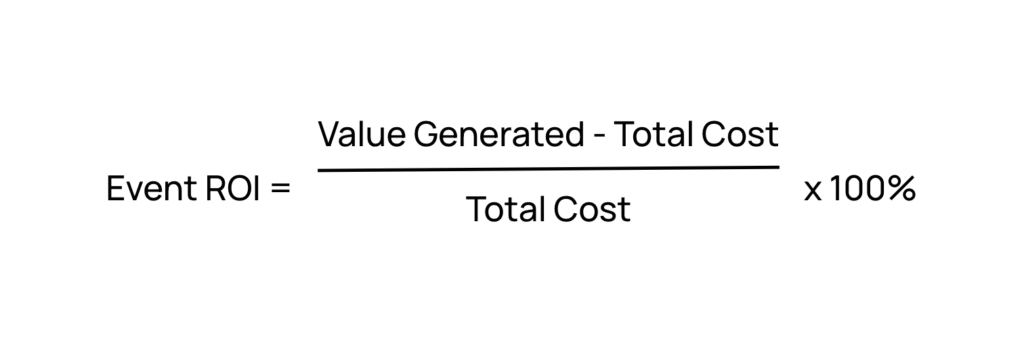
Event planners are under more pressure than ever to prove measurable results. Headcounts and badge scans don’t tell the whole story anymore. Successful organizations are focusing on event ROI, not just attendance, by designing experiences that generate action, connection, and measurable outcomes.
This year’s biggest shift? Turning attendees into active participants. The right interactive event ideas don’t just entertain — they improve attendee engagement and feed the data you need to prove ROI.
This article breaks down six proven strategies to make your next event interactive, unforgettable, and measurable.
What Are Event KPIs and How Do They Define Event ROI?
Let’s start with clarity because language matters when you’re proving impact.
- KPI (Key Performance Indicator): A quantifiable measure tied to your event’s primary goals. KPIs show how well you achieved what you set out to do, whether that’s pipeline influence, lead quality, or attendee satisfaction.
- Event ROI (Return on Investment): The total value — financial or strategic — your event delivers compared to its cost. ROI can include revenue, donations, enrollment increases, or even citizen trust. It’s calculated as:

In this clip, Brad Gillespie walks through the basics of calculating event ROI and teases the other, harder-to-measure benefits that every organization should consider. He dives deeper into how to measure these more intangible markers of ROI in the on-demand webinar: Demystifying Event ROI.
Now that we’ve explained event KPIs and ROI, let’s dive into six interactive strategies that improve attendee engagement.
1. Shift Your Mindset: From Audience to Participants
In the past, event success was measured by how many people showed up. Today, it’s measured by how many people showed up and participated. Interactive strategies are intentional design choices that turn attendees from passive observers into active contributors, sparking conversation, collaboration, and measurable action.
The fastest way to improve event ROI is to replace one-way communication with two-way engagement. In fact, 71% of attendees say they’re more likely to take a post-event action when they can participate actively.
Try this:
- Use pre-event polls to crowdsource breakout topics.
- Run live Q&A or session voting tools to keep audiences engaged.
- Create interactive agendas that let attendees personalize their sessions
2. Hands-On Labs That Turn Learning into ROI
Want to make your content stick? Make it tactile. Attendees remember what they do, not what they hear.
Attendees retain up to 75% more information through experiential learning formats like labs or simulations. These experiences don’t just entertain — they move people to act.
Here are some interactive event ideas:
- Higher Ed: “Bring-your-data” admissions labs that link event participation to deposits.
- Nonprofit: Peer storytelling clinics that inspire repeat donors.
- Healthcare: CME case simulations that strengthen long-term learning and satisfaction.
- Corporate: Solution labs where prospects test workflows live.
Measure This: Track participation, follow-up meetings, and influenced revenue or gifts. When you diligently log these touchpoints, you can directly attribute activity to ROI outcomes.
3. Build Connection Moments, Not Just Content

Networking remains the number one driver of event satisfaction. In fact, 52% of attendees say building meaningful connections is their top reason for attending events.
Try rethinking your agenda structure:
- Host peer roundtables organized by topic or persona.
- Offer executive office hours or Ask Me Anything sessions for high-value attendees.
- Curate matchmaking sessions that pair attendees with shared goals or roles.
Each of these interactive event ideas turns strangers into collaborators, and collaboration creates commitment.
Measure This: Track meetings booked on-site, follow-ups scheduled post-event, and opportunity movement for attendees vs. non-attendees.
4. Blend Digital and Physical Touchpoints
Today’s best events blend digital and physical touchpoints. Whether attendees are walking into a session or checking in virtually, real-time channels like SMS, app alerts, and live polls bridge the gap, connecting on-site experiences with personalized digital interactions that boost engagement. With open rates exceeding 90% for SMS and app notifications, these channels significantly outperform traditional email outreach, ensuring every attendee stays informed, connected, and active throughout their event journey.
Here’s how to use real-time messaging to maximize event ROI:
- Send personalized SMS reminders for sessions, parking info, or last-minute schedule changes.
- Use app notifications to clear waitlists or promote under-attended breakouts.
- Trigger post-event messages based on sessions attended or content downloaded.
Measure This: Every touchpoint becomes an engagement metric. Track how in-person participation data (session scans, booth visits) correlates with digital engagement metrics (polls, notifications opened) to see the full ROI picture.
5. Make Accessibility a Priority
Accessibility isn’t just about compliance. It’s about connection. When everyone can participate, your reach, trust, outcomes, and attendee engagement grow. Gen Z and Millennial attendees, in particular, place high value on inclusivity and transparency.
Simple improvements can make a huge impact to improve accessibility and, in turn, audience participation:
- Add captions and alt text by default.
- Include an accessibility section on registration pages.
- Offer quiet zones, dietary labeling, and sensory-friendly spaces.
- Provide transparent accommodation forms so no attendee feels overlooked.
Accessibility isn’t just ethical. It proves your organization values every voice, which leads to higher engagement, stronger loyalty, and measurable ROI.
Measure This: When you log accommodation requests, feedback, and satisfaction scores, you gain visibility into which inclusive design choices improve participation and outcomes.
6. AI-Powered Personalization (Without Losing the Human Touch)
AI is revolutionizing event planning from drafting agendas to summarizing feedback. But the goal isn’t to automate everything; it’s to use automation to personalize better.
Use AI to draft reminder emails, social posts, or recap summaries, then let humans refine tone, emotion, and context. This balance keeps communication fast, relevant, and authentic.
For example:
- AI drafts your post-event “thank you” note, segmented by session attendance.
- A team member adds personalized details, like the breakout topic or key quote, before it’s sent.
- Automate those personalized follow-ups through SMS or email.
This approach saves time and enhances authenticity, improving conversion rates and event ROI. The win isn’t just efficiency. It’s empathy at scale.
Pro Tip: Want to dive deeper into using AI to design smarter, more personalized event experiences? Read The Ultimate Guide to AI-Driven Event Marketing Personalization to learn how to apply AI ethically while keeping your brand voice and attendee experience human.
The Essential Event KPI List
Every organization measures success differently. The key is aligning your KPIs with your goals, not someone else’s template.
In this clip, Brad Gillespie explains why ROI is always contextual, and how to start building a measurement framework that actually reflects your strategy.
When you’re ready to define your own event ROI model, use the chart below as a guide.
Based on industry guidance and practitioner best practices, many top-performing event programs track 8-12 core KPIs across multiple categories to ensure balanced measurement of attendance, engagement, financial outcomes, and brand impact. Here’s what you should measure to make ROI tangible:
| Category | KPI | What It Measures | Why It Matters |
| Attendance & Conversion | Registration-to-Attendance Rate | % of registrants who check in | Indicates how well pre-event engagement drives attendance (Event Industry Council, 2024) |
| Session Attendance Rate | Session relevance and engagement | Helps identify top-performing content | |
| No-Show Rate | % of registrants who skip | Reveals friction in reminders or timing | |
| Engagement & Interactivity | Poll/Q&A Participation Rate | % of active engagement per session | Reflects event interactivity and audience energy |
| Activities per Attendee | Avg. number of sessions or interactions per attendee | Higher activity = higher retention | |
| Satisfaction / NPS | Feedback and willingness to recommend | Predicts long-term loyalty | |
| Financial / Outcomes | Pipeline Influence | Opportunities or deals tied to attendees | Ties directly to event ROI |
| Gift or Deposit Conversion | Donations, pledges, or student deposits | Reflects tangible impact | |
| Cost per Lead | Efficiency of spend per qualified contact | Shows ROI efficiency | |
| Accessibility & Brand | Accommodation Fulfillment | % of requests met | Measures inclusivity |
| Sentiment Analysis | Attendee feedback tone | Reveals emotional ROI and reputation |
Tracking these KPIs across the attendee journey and visualizing them in dashboards turns guesswork into accountability.
FAQ: Event ROI and KPI Essentials
What’s the difference between a KPI and a metric?
A metric is any data point (e.g., “300 attendees”), while a KPI ties that data to a strategic goal (e.g., “95% attendance rate vs. goal of 90%”). KPIs are your success scorecard.
How many KPIs should I track per event?
Most event leaders track 8-12 KPIs to balance focus and insight.
What are benchmarks for strong event ROI?
ROI benchmarks vary by industry, but business events often aim for 3:1 ROI, meaning every dollar invested produces three in influenced value.
How often should KPIs be reviewed?
Monitor engagement KPIs in real time during events (e.g., participation rates) and review conversion KPIs post-event. Dashboards in Salesforce make this easy to automate.
How do I track event ROI for non-revenue outcomes?
Use equivalent impact measures: student deposits, donor conversions, CME credits, or satisfaction increases. These outcomes still represent measurable ROI.
How Interactive Strategies Feed Your KPI Dashboard
Each interactive event idea contributes measurable signals to your ROI framework:
- Labs & Clinics: Boost pipeline influence, satisfaction, and conversion metrics.
- Networking Moments: Lift NPS, meetings booked, and opportunity advancement.
- Digital Touchpoints: Reduce no-shows and improve follow-up conversions.
- Accessibility: Expands participation and sentiment-based ROI.
- AI Personalization: Enhances engagement rates and cost efficiency.
When all of this data lives inside Salesforce, you can connect the dots between engagement and measurable results. No spreadsheets, no silos.
Event Interactivity Is the New ROI Multiplier
The most successful events don’t just attract attendees — they activate them. Event leaders who prioritize event interactivity transform every session, survey, and follow-up into measurable impact. By combining interactive event ideas, real-time engagement, and data-driven event ROI tracking, your programs move beyond headcounts to deliver true business value.
The path forward is clear:
- Design for participation. Build experiences that invite action from live polls to peer discussions and personalized messaging.
- Measure what matters. Focus on the 8-12 KPIs that connect engagement to outcomes like pipeline influence, donations, or enrollment.
- Prove ROI with confidence. When every event touchpoint lives inside Salesforce, results speak for themselves. No spreadsheets required.
Next Steps for Event Teams
- See it in action: Watch a 30-minute Blackthorn Essentials demo to explore Salesforce-native event ROI tracking and engagement analytics.
- Stay ahead: Download 9 Big Shifts Redefining Events for 2026 — your roadmap to the future of interactive, measurable events.
- Start today: Identify your core KPIs, integrate interactivity into your next program, and turn engagement into lasting ROI.
Your next event shouldn’t just feel successful. You should be able to prove its success.
With the right tools and strategy, every attendee moment becomes a measurable milestone on your ROI dashboard.
Want to Measure the Real Impact of Your Current Event Tech Stack?
Check out The 9 Big Shifts Redefining Events for 2026 — a report on the trends reshaping events and the key metrics that show whether your strategy is working.


